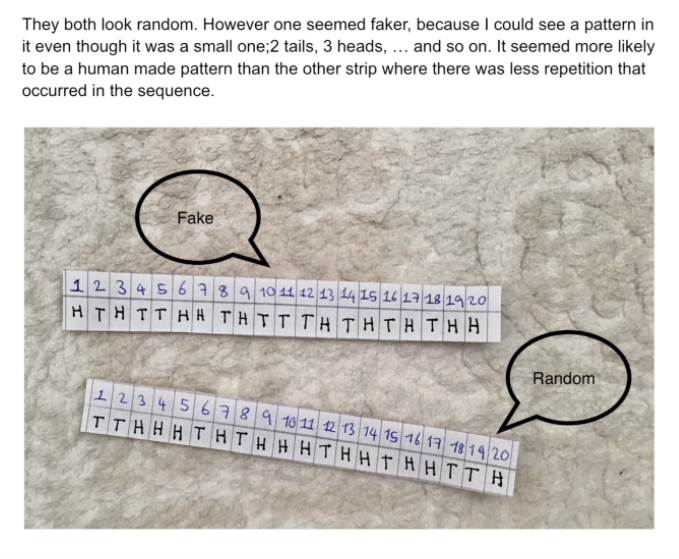Or search by topic
Number and algebra
Geometry and measure
Probability and statistics
Working mathematically
Advanced mathematics
For younger learners
What Does Random Look Like?



- Problem
- Getting Started
- Student Solutions
- Teachers' Resources
Thank you to everyone who got in touch to share their thoughts on this problem. We received solutions from many schools which included Heckmondwike School, Little Ilford School and Wilson's School in the UK, the British International School in The Hague, the British Vietnamese International School of Hanoi, the Frederick Irwin Anglican School and St Phillip's College in Australia, St Vincent's School in France, PSBBMS in India and the Harrow International School in Hong Kong. You seemed to have really enjoyed conducting the experiment and sharing your ideas .
Many of you began by focusing on the probability of tossing either a head or a tail. Kim, from the British International School, shared these thoughts:
Every coin has two sides, heads and tails. If this is a fair coin, then it's 50-50. In my opinion to find the real one, find the one closest to 50-50 in ratio.
Raja, from Little Ilford School, also wondered about the balance of heads and tails:
To tell whether a sequence came from a real coin and a human mind is impossible. However, there are signs which could help someone decipher if a sequence one is real or fake. For example, the probability that a sequence (of 20 flips) that contains exactly an H or T is 1 in a 1048576, which is extremely low. That is a telltale sign that a sequence is fake. What I would expect from a real sequence is about 50% heads and 50% tails because there are only 2 states that a fair coin can be in. If I were to give a range, possibly 45% to 55%, however, remember at the end of the day it all relies on chance.
Sean, who attends Wilson's School, reflected on the sequencing of the heads and tails in his two lists:
My instant reaction when going around this was it should roughly be a fifty-fifty split between the two. Yet when seeing the real version, I realised I would be wrong.
So, when I went back to the drawing board, I realised that there was a common pattern. The more realistic ones are not a “back and forth pattern”. What I mean by this is that there is a low chance that if three heads are in a consecutive row, there is a slim chance there will be three tails in a row. I surmise that one mistake people can make when making a fake string of heads and tails that they are familiar with something in their head so they just write it down again with just a small change. To make it really authentic, you should not do that.
Dilara, who attends the International School in The Hague, also suggested that fake lists tended to include more patterns than real ones. Here's an example that she shared with our team:

Strategies for identifying fake lists featured in several of your responses, including this response submitted by Krithigan from Wilson's School:
I believe that a real coin will not have a specific pattern to it as there were 4Hs followed by 2Ts and then 5Hs [in my list] which shows that you cannot predict what is coming next. However, a fake coin will have a similar pattern as it regularly changed for T to H and vice versa. We think that if we include multiple Hs or Ts it will seem unrealistic but it does the opposite. So we can easily spot fakes using this technique.
John, who attends the Harrow International School in Hong Kong summarised his thoughts:
There is no trick that, when you use it, it will always figure out if a sequence is real or not. But there are a few things you can look for. By themselves, these are not helpful, but when you put them together, you just might be able to figure out if the sequence is real or not:
When there are extreme cases, such as 10 tails in a row, it's usually real because someone making a random squence won't include extreme cases as it doesn't seem random.
Real random sequences are not balanced at all. They usually have more of either tails or heads. If a sequence is very balanced, it might be fake.
People who make random sequences like to repeat ideas. If they have a lot of clusters (a few heads or tails together) at the start, then they are likely to carry on using clusters. If they have a lot of singles (an isolated head or tail), then they might carry on using a lot of singles. Random sequences are more varied.
Try putting yourself in the mind of someone who is making a sequence. Do you think that you could create something like that sequence?
People that make sequences are crafty. If a sequence meets all of the tips above, consider that it is fake, because although these are good things to look for, it is rare that they all apply.
And most importantly, don't let your thoughts limit you. The sequence randomly generated could exceed your wildest expectations.
Thank you to everyone who shared their thoughts about this fascinating problem.
You may also like
Stop or Dare
All you need for this game is a pack of cards. While you play the game, think about strategies that will increase your chances of winning.
Snail Trails
This is a game for two players. Does it matter where the target is put? Is there a good strategy for winning?
Game of PIG - Sixes
Can you beat Piggy in this simple dice game? Can you figure out Piggy's strategy, and is there a better one?

